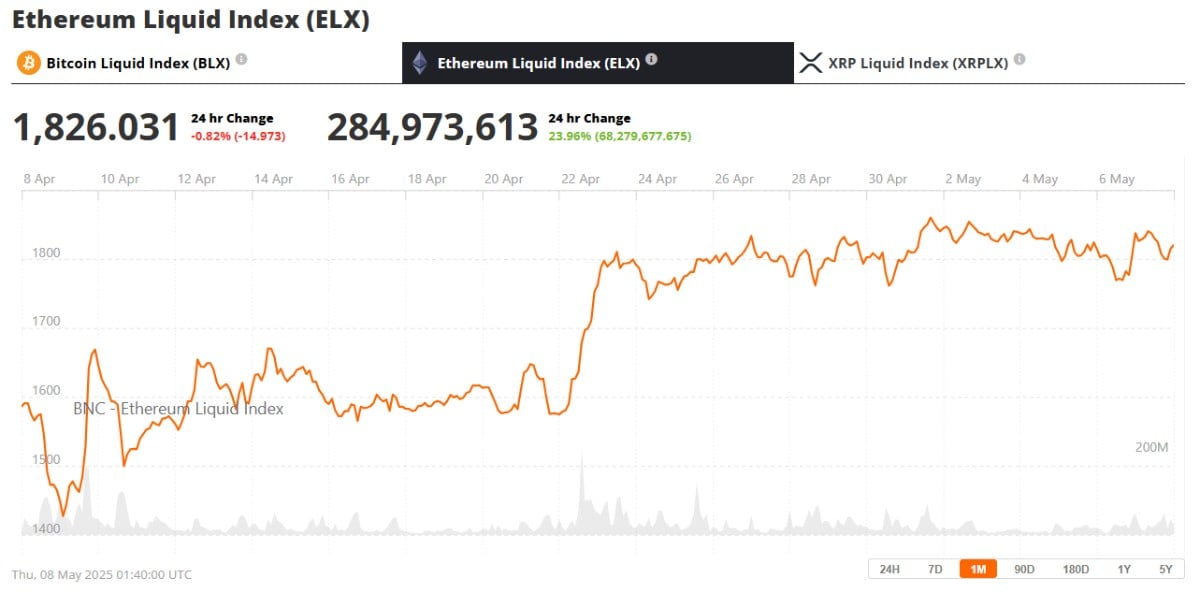Ethereum Pectra Upgrade Launches: Why It’s a Bigger Deal Than the Merge
May 7, 2025
In what experts are calling the most significant update since the 2022 Merge, Ethereum has successfully implemented the highly anticipated Pectra upgrade.

The Ethereum price has remained steady since late April. Source – Brave New Coin Ethereum Liquid Index
The update went live yesterday, May 7, 2025, at 10:05 UTC (epoch 364032), marking a pivotal moment in Ethereum’s evolution toward a more user-friendly, efficient, and scalable blockchain ecosystem. Price reaction has been muted with the upgrade appearing to have been priced into market expectations, and Ethereum’s last major price pump occurring on April 22nd.
What Is Ethereum Pectra
Pectra—a name derived from combining “Prague” and “Electra”—represents a dual-layer hard fork affecting both Ethereum’s execution layer (Prague) and consensus layer (Electra). After an extended development period of approximately 18 months and multiple testnet delays, the upgrade has finally made its way to the mainnet with 11 Ethereum Improvement Proposals (EIPs) bundled into a comprehensive package.
Key Improvements and Benefits
Smart Accounts Revolution (EIP-7702)
Perhaps the most transformative aspect of Pectra is the implementation of EIP-7702, which introduces a significant step toward full account abstraction. This improvement allows traditional Externally Owned Accounts (EOAs) to temporarily execute smart contract code, essentially enabling regular wallets to function with smart contract capabilities.
The benefits for everyday users are substantial:
- Simplified transactions with the ability to batch multiple actions into a single signature
- Gas fee flexibility, potentially allowing users to pay transaction fees in tokens other than ETH
- Enhanced security options including improved recovery mechanisms if private keys are lost
- Streamlined cross-chain interactions without manually switching networks
This advancement lays the groundwork for a much more intuitive and forgiving user experience, removing several friction points that have historically made blockchain interactions challenging for mainstream adoption.
Enhanced Staking Mechanics (EIP-7251)
Another game-changing feature is EIP-7251, which dramatically increases the maximum staking limit for validators from 32 ETH to 2,048 ETH. This 64-fold increase provides significant relief for institutional stakers and large Ethereum holders who previously had to operate multiple validator nodes, each with a separate 32 ETH allocation.
The benefits include:
- Simplified validator management for institutional stakers
- Reduced operational complexity with fewer validator nodes needed
- Enhanced network efficiency with fewer signatures to process per epoch
- Greater flexibility for staking operations of all sizes
This change is expected to drive greater institutional participation in Ethereum staking, potentially strengthening the network’s security and decentralization in the process.

Interest in Ethereum staking has been on the increase since 2024. It is widely thought the Pectra upgrade’s changes to validator node requirments will ease the path for institutional ETH staking. Source: DefiLlama
Improved L2 Scalability (EIP-7691)
Addressing Ethereum’s ongoing scalability challenges, EIP-7691 doubles the blob throughput capacity from approximately 3 to 6 blobs per block. This technical improvement directly benefits Layer 2 solutions, which can now submit more compressed transaction data to the Ethereum mainnet at once.
The impact for users will primarily be felt through:
- Reduced transaction costs on Layer 2 networks
- Improved transaction processing speeds
- Enhanced scalability across the Ethereum ecosystem
Market Impact and Future Outlook
The long-term outlook appears promising, with several key considerations for investors:
- Improved Institutional Appeal: The increased staking limit will likely attract more institutional capital, potentially creating upward pressure on price as more ETH is locked in staking.
- Enhanced Developer Experience: The account abstraction features will enable more intuitive application designs, potentially accelerating development activity and innovation.
- L2 Ecosystem Growth: The doubled blob throughput should make Layer 2 solutions more efficient and affordable, further expanding Ethereum’s utility.
- Competitive Positioning: These improvements help Ethereum maintain its lead in the smart contract platform race, addressing some of the competitive advantages claimed by alternative blockchains.
Conclusion
The Pectra upgrade represents a significant leap forward in Ethereum’s ongoing evolution. By addressing key pain points around account usability, staking economics, and scalability, this update reinforces Ethereum’s position as the leading smart contract platform while laying groundwork for more user-friendly blockchain experiences.
For Ethereum holders, these improvements suggest a strengthening technological foundation that could translate to increased adoption and utility—potentially supporting long-term value appreciation beyond any short-term market movements. While Ethereum developers and users celebrate Pectra’s successful deployment, eyes are already turning to Ethereum’s next major upgrade, codenamed Fusaka. This future update is expected to introduce additional scaling improvements and further refinements to Ethereum’s account abstraction journey.
Search
RECENT PRESS RELEASES
Related Post




